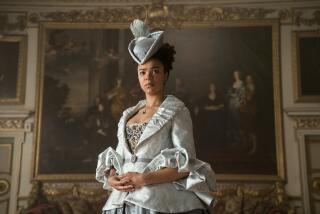Politics Wields a Powerful Palette
- Share via
NEW HAVEN, Conn. — They were the pinup girls of centuries past: curly-haired courtesans, dripping with pearls and swathed in silk, gazing at the world with bedroom eyes.
The women who helped give the Restoration period in English history its reputation for debauchery and political intrigue are depicted in portraits for a new exhibit at the Yale Center for British Art.
“Painted Ladies: Women at the Court of Charles II” features dozens of portraits of the king’s lovers and confidantes, his out-of-wedlock children and his unfashionable Portuguese wife.
Most of the portraits have never before been seen in the United States and many could be viewed before the exhibit only in the private homes of British aristocracy, including the family of Princess Diana, said Julia Marciari Alexander, an acting curator of the museum.
The show, which previously was shown at the National Portrait Gallery in London, opened Jan. 25 and runs after March 17.
Charles II took the throne in 1660, following a brief period in English history in which there was no monarch. Charles I had been executed in 1649 after the English civil wars, and Oliver Cromwell headed a commonwealth government that lasted until the restoration of the throne.
The new, fun-loving king immediately set about creating a court, reestablishing the high society of his father’s day, said Catherine MacLeod, curator of 16th and 17th century collections at the National Portrait Gallery in London.
“The king appointed a principal painter to produce visual propaganda that in a lot of ways summed up what his court was like and how they wanted to be seen,” MacLeod said.
During this period, when royal marriages were made more for political or economic reasons than for love, it was normal for the king to have many mistresses and for the women to hold powerful positions in the court. Supporters of the king sometimes displayed portraits of his mistresses in their homes as a sign of loyalty, MacLeod said.
As the women sat for these portraits, they had much in common with today’s publicity seekers: Some of the women tried to control their public images and send messages about themselves--not just to the king and denizens of the court but to the public at large--through the poses selected for their paintings.
The queen of self-promotion in the exhibit is Barbara Villiers, Duchess of Cleveland, who was Charles II’s chief mistress for a decade.
The duchess, with her long nose, cascading dark hair and heavy-lidded eyes, is depicted in various portraits as a shepherdess festooned with garlands of sapphires, as St. Catherine leaning on a sword and even with her infant son by the king in a pose usually reserved for religious paintings of the Madonna and child.
The image leads to the conclusion that Charles II himself must be God, Alexander said.
“She is not always naughty and not always nice. She is interested in creating intriguing images of herself,” Alexander said.
The king’s other principal mistress, Louise de Keroualle, Duchess of Portsmouth, was less interested in self-promotion and more interested in the art and fashion of her native France. The duchess, who came to Charles II’s court as a French spy, rejected the painting style of Villiers’ favorite, Peter Lely, in favor of French painter Henri Gascor.
The exhibit also features a portrait of Nell Gwyn, who gained fame as a comic stage actress and entered the lives of the aristocracy as another of the king’s mistresses.
Among the shining silks, gleaming jewels and peaches-and-cream bosoms of the king’s lovers, portraits of one woman stands out: Catherine of Braganza, the unlucky wife of the king.
Catherine is depicted in the dark and unfashionable Portuguese court dress, with her awkward hairstyle and mousy look.
“She plays a low-key role in the court of Charles II, unfortunately for her,” MacLeod said.
More to Read
The biggest entertainment stories
Get our big stories about Hollywood, film, television, music, arts, culture and more right in your inbox as soon as they publish.
You may occasionally receive promotional content from the Los Angeles Times.










